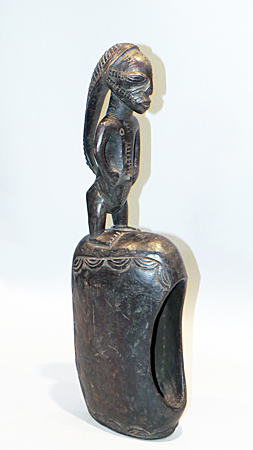
Owner: HWMC
Catalog#: AF-IDST-139-14
Slit Drums
Tabwa Slit Drum
Democratic Republic of the Congo, Lake Tanganyika region
Tabwa
Wood
Mid 20th century
Length: 21.2 inches
Idiophone – Struck Directly – Slit Drum
The Tabwa people (also known as Lungu, Rungu) live in small autonomous villages within a region from the southeast of the Democratic Republic of Congo, and in southwestern Tanzania and northeastern Zambia, along the southwestern shores of Lake Tanganyika. They have developed a system of religion honoring the ancestors, similarly to the Luba and have utilized this system in a way which benefits the traditional leaders, who use the remembered power of their ancestors to explain their current power. Ancestors are embodied in figural sculptures known as mikisi (nikisi-singular), which are carved by religious specialists, and given offerings of food during the new moon, a time which is of great importance to the Tabwa. The new moon is represented by the triangle in Tabwa iconography and symbolizes rebirth and the continuity of life.
This Tabwa slit drum consists of a standing female figure with hands resting on the abdomen and a long, braided hairdo which extends down the back to the waist. Scarifications, which embellish the body and face is shown to help recall social values. On the body and face, a recurrent motif consists of incised geometric markings, while the back of the hair features a beautiful triangular carving.
Resource: Tabwa – Art & Life in Africa – The University of Iowa Stanley Museum of Art (uiowa.edu)
